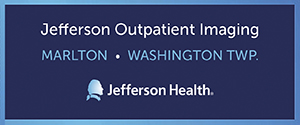
While October might be winding down and Breast Cancer Awareness Month along with it, diseases and diagnoses can come at any time—which is why the region’s health care professionals so ardently pound the drum of preventive measures and proactive care all year long.
Despite the month’s dedicated awareness campaigns dating back to 1985 and educational efforts taking place everywhere from classrooms to one-on-one patient and doctor conversations, some potentially dangerous myths, old wives’ tales and misinformation have stubbornly continued on despite being factually incorrect, much to those professionals’ frustrations.
“One of the most common [misconceptions] is thinking that not having a family history of breast cancer means you won’t get breast cancer—but that doesn’t keep you from being at risk,” says Dr. Sherrill Little, the head of women’s imaging at South Jersey Radiology Associates, or SJRA. “The other one, which I still hear at least once or twice a month, is asking if doing a biopsy or a surgery exposing the cancer to air or poking it with a needle is going to spread their cancer everywhere. … And that’s all not true. That’s one of those myths people should disregard. So is saying that using deodorant causes cancer: Since most cancer occurs in the upper, outer part of the breast, sometimes people think that, since that’s where the deodorant goes, that’s what causes it—that’s not true at all. More breast cancers in the upper, outer quadrant because that’s where most of the breast tissue is.”
In addition to those persistent fictions, other hurdles to timely treatment and early diagnoses are born of more modern challenges. As many people were understandably reluctant to keep up with routine medical exams and regular checkups during peak COVID and its accompanying lockdown, the area’s care providers have seen a worrisome correlative uptick in advanced cancers that could have been easier to treat, or even less life-threatening, had the patient been more diligent about keeping up with their mammograms, annual checkups and self-exams.
“The pandemic certainly got people out of their normal routines but delaying care is a problem all the time,” Dr. Little continues. “I see people who haven’t had a mammogram in 10 years and come in with a lump and it’s breast cancer, and that happened during the pandemic—but it happens every day. We see people who aren’t getting mammograms routinely and come in with cancers that certainly could have been found earlier and could have been more easily treated than when it’s more advanced.”
It’s important to remember that preventative guidelines are best practices for the general public, and those who know they’re at a higher risk for breast and other cancers should be a little more assiduous in both their self-monitoring and professional exams. For example, when increased risk factors like a known family history of breast cancer are present, an individual should have started going in for mammograms before the recommended age of 40.
“For any patient that has a first-degree relative diagnosed at a young age—50 years or younger—they should have breast exams and imaging ideally 10 years earlier,” says Agata Kraszewska, an advanced practice nurse at Lindenberg Cancer and Hematology Center. “If you had somebody in the family diagnosed at 46, you would want to start [getting mammograms] at 36, or even earlier. And then also for those patients, genetic testing for things like BRCA1 and BRCA2 [BReast CAncer genes 1 and 2], that’s really important. We’ve had many patients come to us with a family member that had a breast cancer and they find out they have this gene, and then they’re able to reduce their risk significantly with different surgeries or just imaging more frequently.”
Risk factors aren’t just genetically inherited ones, though—in fact, Dr. Little notes that “85% of women who get breast cancer have no family history.” External factors and bad habits like a sedentary lifestyle, unhealthy eating habits and smoking can all be contributing causes of breast cancer, as can hormone-replacement therapies and even taking certain types of birth control. Additionally, while one’s age in years and one’s physiological age—the age of the body adjusted to measure one’s physical state and general health relative to their actual numerical age—may differ, the chances of being diagnosed with breast cancer do increase as a person grows older, and especially after menopause settles in.
With cancer diagnoses occurring in younger and younger patients these days, local care providers emphasize that proactive preventative care is increasingly important for everyone. That’s where self-exams play a particularly critical role, especially since no one knows your body as well as you do, and there’s more to detecting cancer than checking for lumps: It’s about assessing your breasts as a whole so you’re attuned to any puckering, discharge or other suddenly appearing abnormalities.
“Breast exams will often find cancers that are hard to see on mammograms, particularly in people with dense breast tissue,” Dr. Little explains. “It’s always a good idea to keep up with that. A lot of times women will say that everything feels lumpy, they don’t know what they’re feeling and they panic about everything. But over time, people kind of get used to what’s normal for them and what isn’t, and they can pick up small things that even a professional won’t because they don’t always know what’s normal for that patient.”
There is some good news in the field of breast cancer, though, as Kraszewska notes some experimental treatments are offering hope and progress with some potentially promising results.
“We’re definitely moving forward with different types of cancer care,” she says. “For example, in early-stage breast cancer, there’s trials going on currently combining a hormone pill along with what we call a CDK4/6 inhibitor—that’s usually something that we use later on in more metastatic patients, but now we’re finding that we can actually bring a treatment that we would give in a different setting a little bit earlier on. And we’ve found that … about 25% less people may reoccur with this disease. So I’m curious to see how we can use these treatments in different stages because, otherwise, these patients would be stuck with IV chemotherapy, and we can potentially avoid that with a pill or two.”
No matter what advancements are made in the field of breast cancer care, detection and treatment, proactive monitoring and knowing your body remain two of the best ways to promote early detection of breast cancer. The earlier the intervention, after all, means the better your chances you have of an optimal, optimistic prognosis.
“With breast cancer, it’s very easy to do preventative care,” Kraszewska says. “Preventative care is key, but it’s very easy to put things off, whether it’s because of a pandemic or moving or this or that life event. But cancer does not wait, so it needs to take priority no matter what.”
Battling Breast Cancer
Area providers, expert care
|
Comprehensive Cancer & Hematology Specialists, P.C. |
Jefferson Outpatient Imaging |
|
Larchmont Medical Imaging |
Regional Cancer Care Associates |
|
South Jersey Radiology |
Click here to subscribe to the free digital editions of South Jersey Magazine
To read the digital edition of South Jersey Magazine, click here.
Published and copyrighted in South Jersey Magazine, Volume 20, Issue 7 (October 2023)
For more info on South Jersey Magazine, click here.
To subscribe to South Jersey Magazine, click here.
To advertise in South Jersey Magazine, click here.












